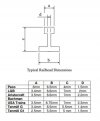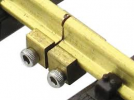Why are these measurements critical to you ? Generally you can mix and match most 45 mm track systems as they have similar cross sections but not all do, some will need an adapter to join together. Most rail used in these systems fall into the description of "code 332". The 332 refers to the height of the rail from its foot to the rail head measured in thousands of an inch. This is standard practice across all the different rail types used across all scales. Most code 332 rail produced is flat bottom section and most fall into proportions to be the same or a near match in to that used by LGB the past predominant supplier. If you want to sell your product you need to be able to be compatible with LGB, or near as dammit. Compared to other 45 mm rail used in "finescale" track systems, like those for use with Gauge 1, it is quite chunky. The primary suppliers of code 332, and generally accepted as compatible to LGB without modification are - LGB,Trainline,Aristocraft,USA Trains,Piko, Bachmann. There are others. Some specialist 45 mm gauge track system maker use LGB's, and others, rail to make up specialized track pieces or whole systems. There are one or two Code 332 suppliers where an adapter will be required to join to other mainstream code 332 systems, Tenmille comes to mind here. It is possible to join other different code sizes, like Peco's G45 code 250, where the railhead heights are matched at the same height when joining with the correct adapter. I hope that helps. It;s that or getting the digital calipers out in any sample you can get hold of

Max



